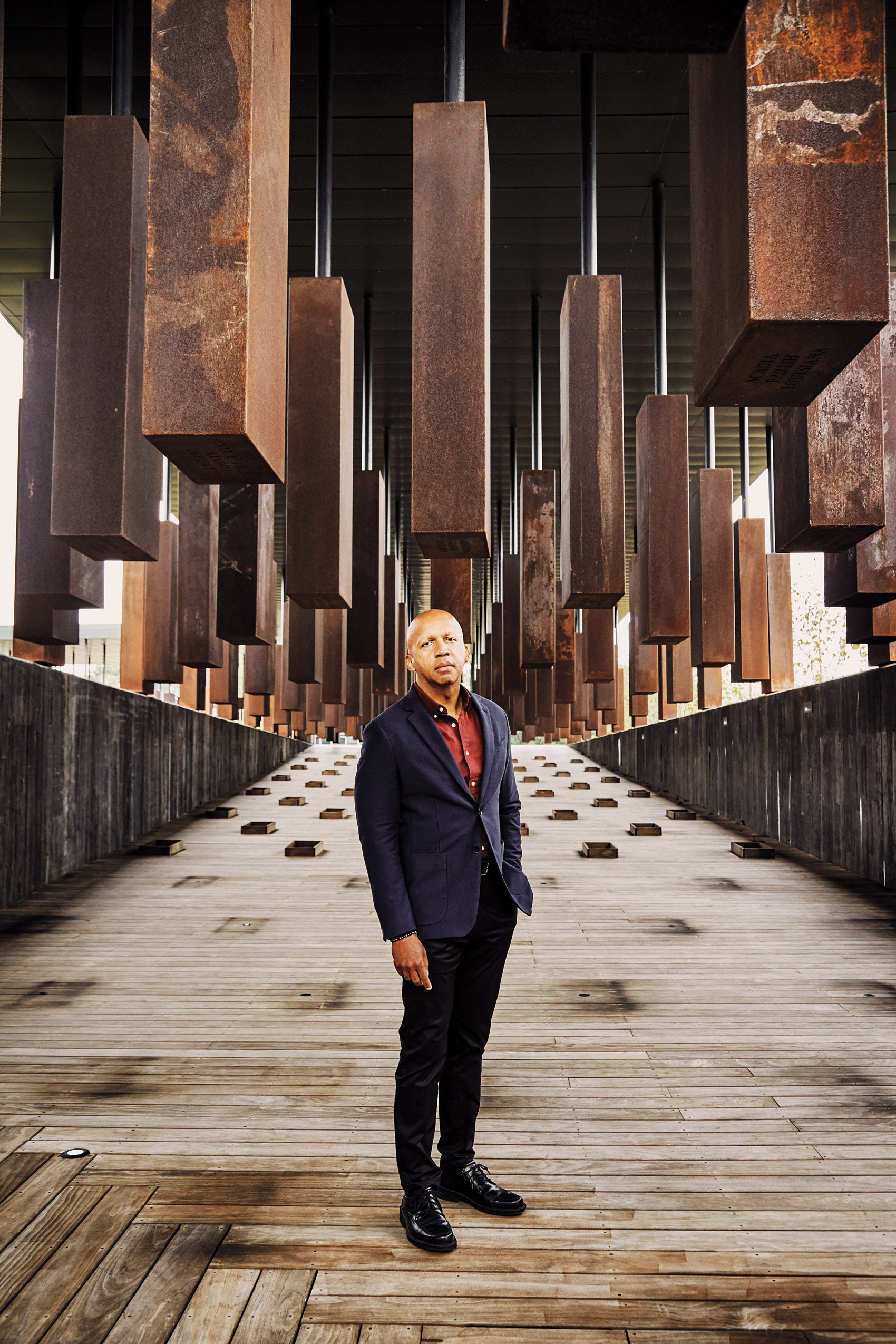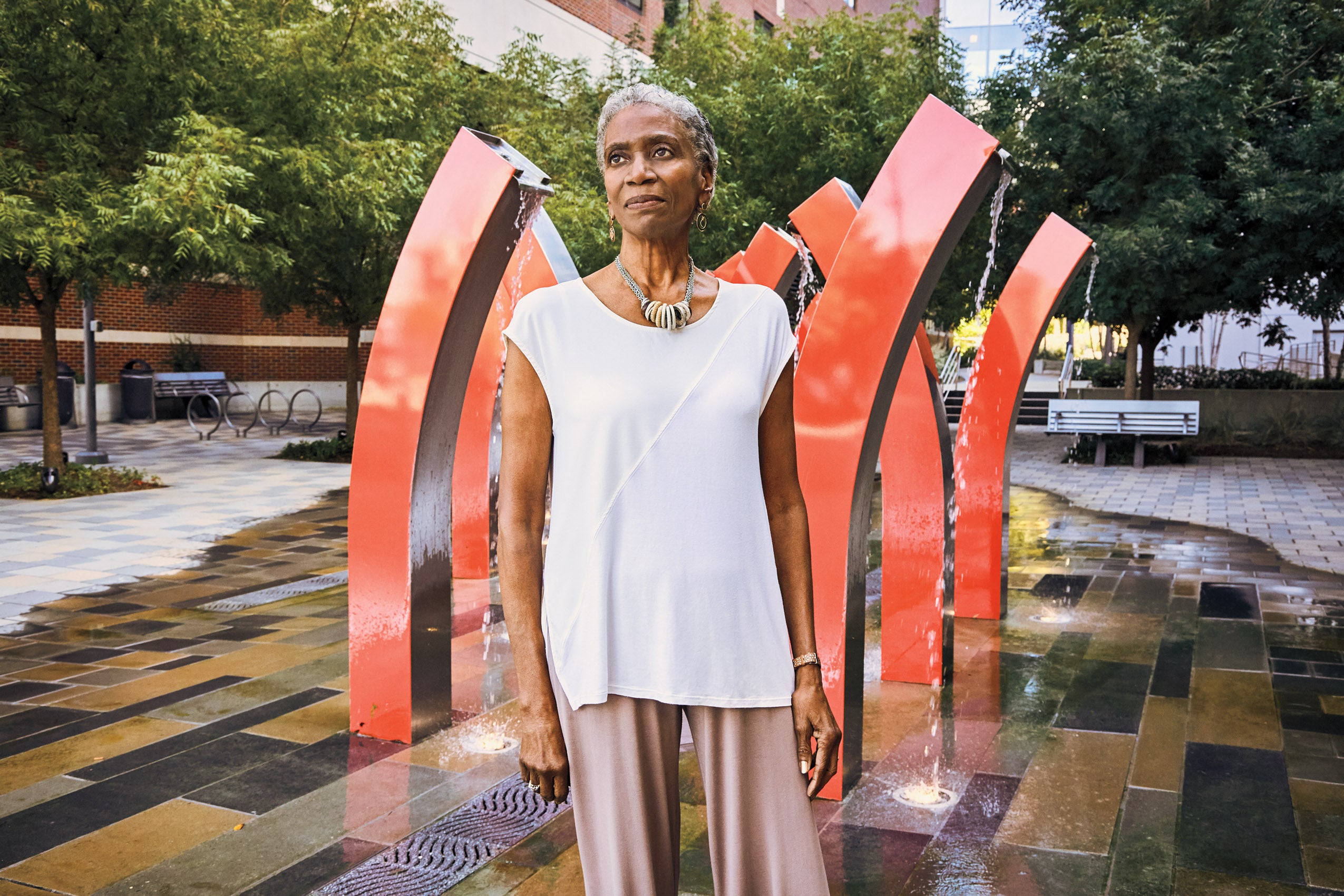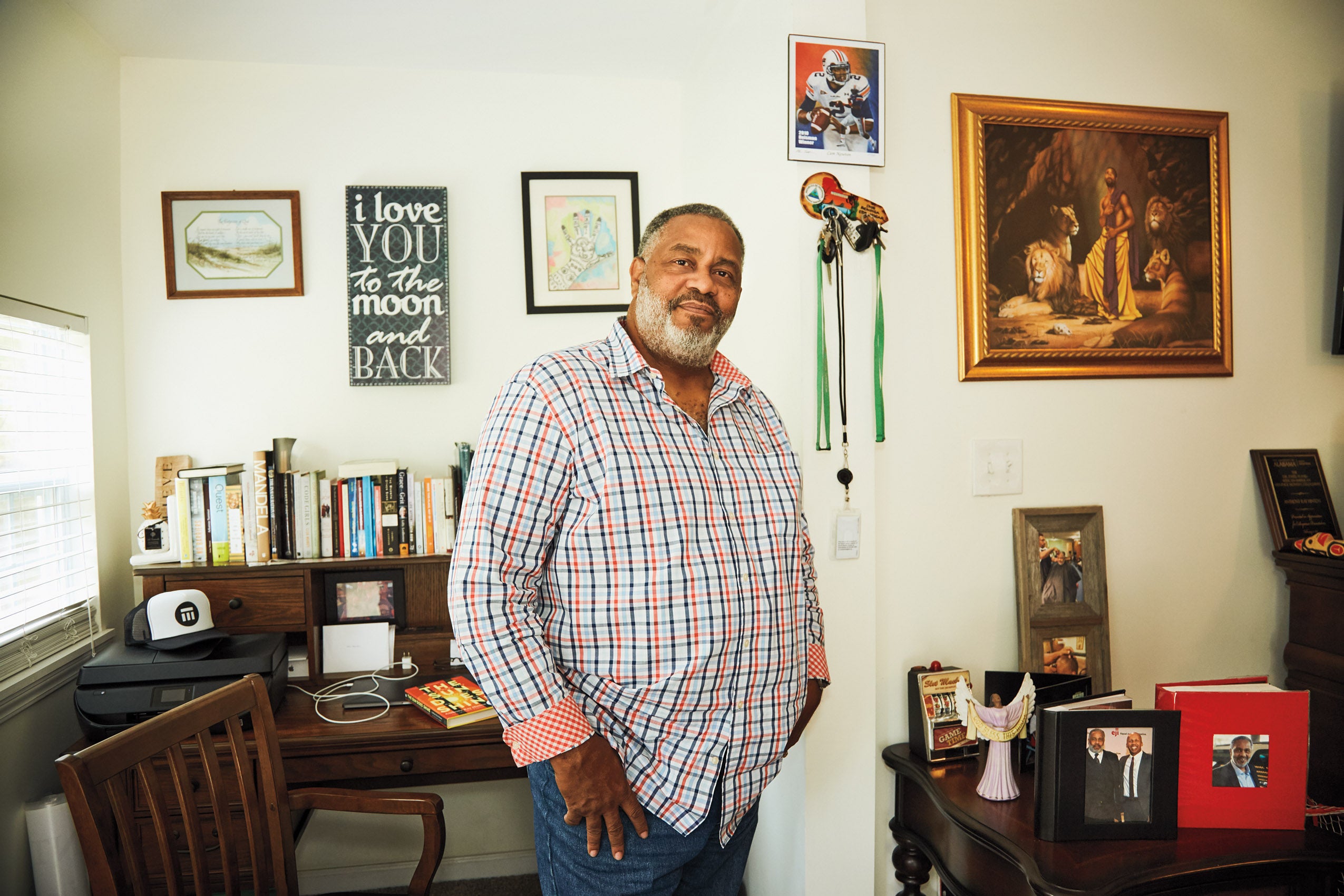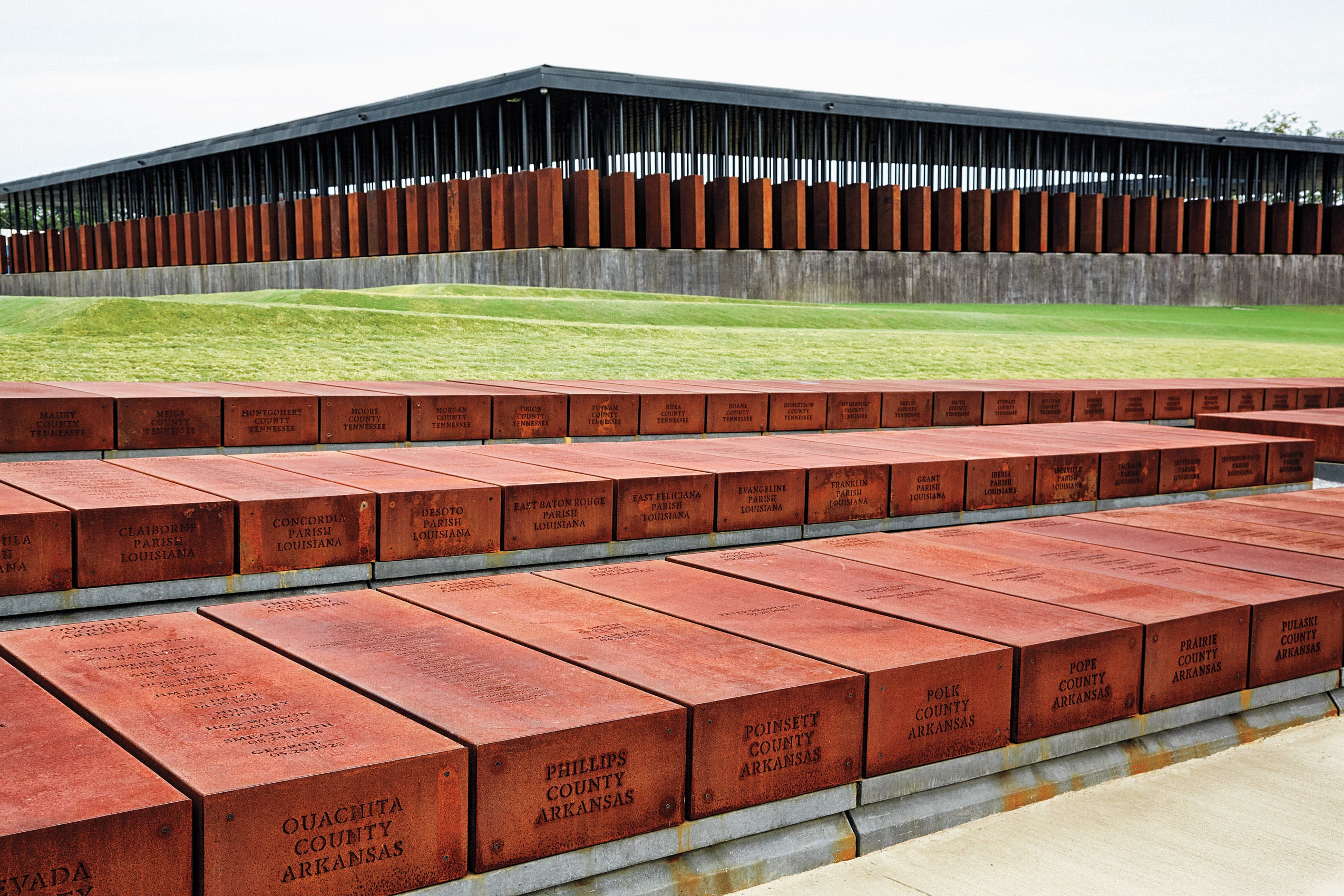On a blue-sky autumn day in Alabama, you sit in a field, your head tilted to the trees. You are wondering if they stood here 81 years ago, when Wes Johnson was hanged from the limb of another tree, very near where you sit. Did he look across this county road and see the grace of those branches, hold onto it, with the mob in motion below?
It is quiet where you are. A pickup truck passes slowly by with white people in it—a man at the wheel, a boy by his side. A few minutes later, the driver circles back and pulls into the field; he has seen your car parked in a ditch down the road.
“Can I help you?” he asks.
“Oh, no, I’m fine,” you say, smiling.
But then you remember the photograph, back at the Legacy Museum in Montgomery, of the legs of a lynched man dangling at the top of the frame. Below is a mass of white faces. Smiling is not what you do when you are sitting in this field.
“I’m just here because this is where someone was lynched and I wanted to pay tribute,” you say.
The man jerks his head back.
“Someone was lynched?!” he says.
“Many years ago,” you say. “His name was Wesley Johnson.”
And then:
“How did you find out?”
If he drove 100 miles or so north, the man would see soil from this field in a mason jar with Wes Johnson’s name on it, one of 300 that line shelves in the Legacy Museum, which the Equal Justice Initiative, a legal advocacy nonprofit, opened last spring. If he walked another 10 minutes from there, to the National Memorial for Peace and Justice, he would see 800 rusted steel columns—one for each county in the United States where EJI documented lynchings. Wes’ name is there, too.
But in this empty field near the small town of Abbeville, there is still nothing. So it makes sense when the man says it.
“I didn’t know.”

At some point, Bryan Stevenson ’85, the founder and director of EJI, who has helped win reversals, relief or release for more than 125 death- row prisoners, came to a realization: The law would not be enough. No matter how much bias he exposed, there was a narrative of racial difference at work—in the courts, and in American life—and it was terrorizing black people.
It had traveled down the years from slavery, inspiring a white mob in 1937 to lynch Wes Johnson for a relationship with a white woman; pushing his cousin James out of Alabama in 1965 for integrating a cafe; encouraging an all-white jury to condemn Anthony Ray Hinton to death in 1986 for a crime he didn’t commit.
Slavery was to blame for that narrative. But nobody had started a national conversation about that. On a panel one day, Stevenson suggested it was time.
“I remember people looking at me like: What is wrong with you?” says Stevenson. “All these issues, and you want to talk about that?”
He did. Stevenson had seen other countries create space for truth-telling in the aftermath of atrocities—Rwanda, South Africa, Germany. In the questioning and conversations that followed, there was a way forward for all.
For years, he waited for a museum to tell the story of how slavery seeded the myth of racial difference—and how that lie led to lynching, which led to Jim Crow segregation, which led to mass incarceration, which led to the projection that one in three black boys will go to jail or prison in their lifetime. Then Stevenson realized the work couldn’t wait.
“I just felt like there was a community of people who were ready, who were willing—even desperate—for their stories to be told,” he says.
EJI had already been investigating lynchings all across the South, combing through archives, confirming reports through news sources, sitting in people’s homes for hours to hear their accounts. The report from that research led to EJI’s Community Remembrance Project, with relatives and strangers visiting the lynching sites, collecting soil, then sharing their experiences at events. From there, the memorial to the lynching victims began to take shape, along with the museum.

Originally, Stevenson hired historians and museum experts to guide the museum project, but they pushed for a more academic kind of telling. And working on death-row cases, in the state with the highest per-capita execution rate in the country, Stevenson knew the power of personal stories. He was set on telling them, in ways as small and powerful as a letter from prison. So the team at EJI pushed forward on its own.
Bryan Stevenson had waited years for a museum to tell the story of how slavery seeded the myth of racial difference. Then he saw the work could not wait.
And in April, it opened: a narrative museum that draws a straight line from slavery to mass incarceration, and a memorial with the names of 4,400 lynching victims—and the states and counties where they were killed—engraved into steel monuments at the center of a 6-acre site.
“I don’t know if I can make it to the end,” said a middle-aged man at the Legacy Museum recently, turning to his wife.
They had already walked down the darkened corridor of the former slave warehouse, with its series of pens, where actors projected as holograms animated the words of slaves—in pleas, in narratives, and in song.
Before them were mounted news clippings showing thousands of people at a lynching. Behind them, banners hung from the ceiling, listing dozens of sale notices—one for Tilla, another for Isaac, another for Little Judy. To their right, further down the timeline, the image of a smiling white boy, holding a sign: We won’t go to school with negroes.

“One of the brilliant things that the Legacy Museum does is it paints the picture of cause and effect,” says Vanzetta Penn McPherson, a retired U.S. magistrate judge well-known for litigating racial and gender discrimination cases. “It’s all right there before you, and if you go from the beginning to the end, if you are a reasonable person, you have to be convinced.”
Given the urgency of EJI’s legal defense work, Stevenson says, some thought this focus on slavery was a detour. Not McPherson, who grew up in Montgomery walking the same streets as Ku Klux Klansmen in their robes.
Until EJI erected historical markers in 2013, Montgomery had 59 markers or monuments to the Confederacy, and not a single one to acknowledge its past as one of the biggest slave ports in America. The city’s two largest high schools, which educate primarily African-American students, are still named after heroes of the Confederacy. When McPherson heard Stevenson was planning the memorial in Montgomery, she had just one reaction.
“Oh, I was so happy,” she said. “The story was going to be told.”
For the most part, Stevenson also had the support of his clients, many of them people of color—from children sentenced to life in prison to adults with severe mental illness condemned to death. Sometimes, when they are struggling to understand how they got there, Stevenson uses history to explain.
“The essential question that most clients ask me is: Why?” says Stevenson, whose best-selling memoir, “Just Mercy,” examines systemic racism in the criminal justice system through his clients’ stories. “Why does nobody care? Why am I being thought of in this way?”
Some of the answers are in that museum. The more people visit, Stevenson hopes, the more a consciousness will grow.
“I would love to see a generation of black people not burdened by the presumption of dangerousness and guilt,” says Stevenson. “I would love to see a generation of people, both black and white, not constrained by the weight of this history, as they currently are today.”
Since April, more than 300,000 people have visited from across the country and around the world. EJI is working on a visitors center across from the memorial; developing a curriculum for educators; and expanding its website to include even more videos, data and stories from the museum.
When young people say to Stevenson that there’s never been a harder time in this country, he pushes back and points to the past. People endured far worse than you, he tells them. You can survive. You can overcome. Look at the history and you will see the heart and the will and the strength of your people.

Every morning, Anthony Ray Hinton rises at 2:45, as he did for nearly three decades on death row. He makes himself a stack of three pancakes and cooks himself four pieces of bacon in the comfort of his own home. He decides on a book from his shelf, then settles in to read it. But before any of that, Hinton, 62, sets his mind to thinking.
He just sits there on his living room couch and tries to work it out: How can we get rid of this racial hatred?
“I truly believe there’s an answer right at our fingertips,” he says. “And if we can figure out the right way to present it, we can wipe out racism.”
In the Legacy Museum, at the heart of the mass incarceration exhibit, Hinton tells his own story in question form. Sit down at one of the prison visitation booths, and you’ll see him there on a screen, blinking at you until you pick up the phone. Then come the questions he would like you to consider:
What would you do if you were sentenced to almost 30 years on death row for a crime you didn’t commit?
How would you survive?
Who would you be?
Three years after Stevenson secured his freedom, Hinton is a community educator with EJI. He is the author of a memoir, “The Sun Does Shine.” He is the best friend of Lester Bailey, who visited him every month for 30 years, and the proud son of Buhlar Hinton, who died before she could see him released.
And in the name of no one else suffering as he did, he will keep telling his story, even when it hurts.
It is the story of a 29-year-old black man wrongly convicted for two murders on the basis of flawed evidence, poor representation and a weak expert witness. It is the story of state officials twice refusing to spend the hour they said it would take to review exonerating evidence, leaving Hinton on death row for 16 years after Stevenson brought the new evidence to light.
And it is the story of how, as Stevenson likes to say, slavery never ended; it simply evolved.
Hinton chooses to be joyful despite it. He chooses not to hate the arresting officer who told him it did not matter if he committed the crime—that he was black, that the jury would be white, that the judge would be white, and that it would all add up to a conviction. Hating that man, and so many others, would only keep him up at night.
Instead, every night at 10:30, he walks out into his yard to look at the moon and the stars. Such a beautiful painting, he thinks. He carries an image of it on his phone, so that when he’s speaking outside of Alabama, he can pull it up and admire it.
“The joy I have, the world didn’t give it to me, and the world can’t take it away,” he says.
As soon as Hinton heard that EJI was creating a museum and a memorial, he wanted to be a part of it. Some people think it’s opening an old wound; Hinton thinks it’s closing one.
When he walks the downward-sloping path of that memorial, and those 6-foot-tall steel monuments rise above his head like so many men and women lynched, Hinton thinks of their sacrifice.
“If you got any kind of soul, any kind of feeling for humanity, you can’t help but to shed a tear,” Hinton says.
Their sacrifice led to the end of lynching, is how Hinton sees it. So maybe his own sacrifice will matter, too. Maybe it will educate free people to push back against the death penalty—just another form of lynching, in his mind. And maybe it will help his friends still waiting on death row. One day, he plans to go back, and pass along a message: Hold your head high. There is hope.

In the small town of Abbeville, James Johnson grew up wondering why. Why did he have to climb the side stairs of the movie theater, and sit in that separate space? Why did he have to eat in the hot, dingy back room of a restaurant, with broken-down tables and chairs, separated from white life by a door?
The answer came back simple: That’s just the way it is.
“And I could not accept that,” says Johnson, now an educator at a local school for at-risk youth.
When Johnson was just a boy, his mother told him about his cousin Wes, who was hanged for dating a married white woman. Johnson can still remember how tightly his mother held his hand as she said those words.
It was a warning passed down from one generation to the next, and it kept him quiet for a while. Then, as the resentment grew, it didn’t.
In the summer of 1965, Johnson walked with a friend through the front door of the Star Cafe. They had tried to integrate the pharmacy earlier, but in anticipation, someone had pulled the seats from the stools, leaving only spikes.
The Star Cafe was not expecting them, so Johnson walked right into a world he never knew existed.
“Real clean, nice music, big picture windows for you to look out of,” he recalls. “It was: OK, so this is what we’ve been missing.”
When his grandmother got the anonymous call, advising her to “chastise” her grandson, they both knew what it meant. For her sake and his, Johnson left, joining the millions of African-Americans pushed out of the South by what Stevenson calls racial terror.
Those years in the North changed him. He worked for a man with a number tattooed on his arm, a Jew who understood the pain of oppression. He learned from international students and professors, broadening his idea of what life could be. And when he came back to Abbeville in the late ’70s, a college graduate, Johnson was different.
“The hatred had gone,” he says.
He became a teacher at Abbeville High School, which was whites-only when he left. He created the school’s first black history program and, at the students’ request, helped them to integrate their prom.
He still sees some of those students today, many of them white. They call him Brother Johnson. They embrace him openly on the street.
“It was hell when I was growing up,” says Johnson. “But this is home.”

When he first visited the memorial, Johnson gravitated toward the life-sized sculptures of men and women straining in chains. He walked up to them. He took pictures of them. He wept.
Then he wandered over to the grass where replicas of the steel monuments are laid out in rows like coffins. EJI has invited each county to claim its replica and to install that monument on its land. Nearly 300 counties have already expressed interest—far more than Stevenson expected.
Johnson was looking for the name of his county that day when he met a woman looking for the name of hers. He listened to her story, of finding her father shot dead by the side of the highway, the target of a white man who didn’t like her father’s success. The woman was 5 years old at the time.
“It’s sort of like being at a wake, where you can cry on each other’s shoulder,” Johnson says.
Stevenson has seen older African-Americans come to the memorial to find their county, knowing they have some distant family tie, only to discover the name of a relative cut into the steel.

“You see these people wrapping their arms around these monuments and just sobbing,” says Stevenson. “And I’ve seen white people find their county, see the names, and be utterly destroyed by it and just sit there and weep.”
For so many years, Johnson never knew what happened to his cousin on that county road outside of Abbeville. It took a relative’s research to tell him how the mob of 50 men pulled the teenager out of jail, drove him down to the house of the husband, shot him several times, then hanged him.
The idea of it haunts Johnson every time he drives by.
“I try to imagine the expression on his face, the thoughts in his mind, what he might have been trying to say,” Johnson says.
Last January, Johnson and his family stood with Stevenson where it happened. Beside them was Oprah Winfrey with a camera crew, filming for a “60 Minutes” segment. Stevenson said a few words in Wes’ honor, then handed a small shovel to Johnson to dig the soil that would make its way to the Legacy Museum.
After all these years, Wes’ story would finally be heard; Johnson could share it with the world. But it meant just as much to him to share the story with the people of Abbeville. In the days after the segment aired, a county employee, a young white woman, approached Johnson to say she was sorry for what had happened. That she had no idea.
“It just gives you some closure,” Johnson says.
When his former students got in touch to apologize, Johnson reassured them it wasn’t their fault. Don’t hate your grandparents, he added; they got caught up in the frenzy of things.
“Each of us is more than the worst thing we have ever done.” It’s something Stevenson often says, and Johnson believes it.
But for the sake of the future, Johnson had something else to say to his former students. Now you know better, he told them. And it’s up to you to pass that on—to your children, and to everyone else you know.
***
BULLETIN EXTRA
